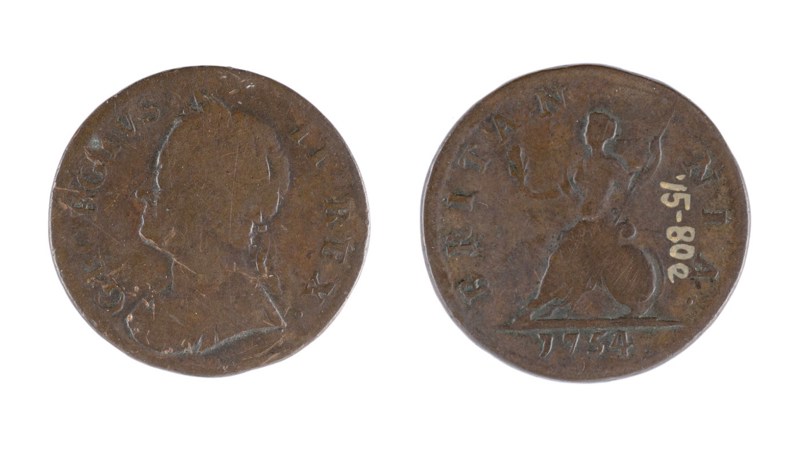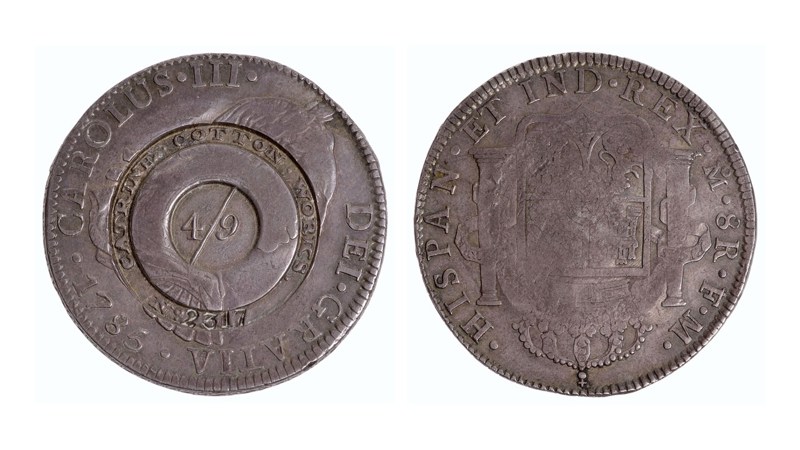Coins of Empire

Copper farthing minted during the reign of King George II (1727-1760)
Found in the foundations of an old tenement on the west corner of Charlotte Street and Gallowgate.
1915.80.e
Images © CSG CIC Glasgow Museums Collection
21st March 2021
In 1944 Eric William’s book Capitalism and Slavery was published. He points to capitalism as being the main driving force behind the trade in enslaved African people being forced to work on colonial plantations in the Americas and there may be no clearer symbol of capitalism than money. Great Britain dominated the European slave trade. Glasgow Museums’ collection of coins and trade tokens minted in the 1700s, mark the high point of the trade’s importance to the British economy.
Looking at the coin 1915.80.e we see a fairly worn down copper farthing minted during the reign of King George II (1727-1760), which was found in the foundations of an old tenement in Glasgow on the west corner of Charlotte Street and Gallowgate that predated David Dale’s development of the surrounding area. Today Dale (1739-1806) is famed as an industrialist who invested in Scottish cotton mills such as New Lanark, and Catrine. He was also a property developer in Glasgow in the 1780s who invested in developing Charlotte Street and surrounding streets to the west end of Glasgow Green. Some of these properties were rather grand and intended for wealthy people. Dale himself had a house built for himself on Charlotte Street based on a design by the architect Robert Adam (1728-1792).
Due to the international nature of trade, foreign coins were often re-used locally. This is evident from a trade token made for David Dale’s Ayrshire cotton mill at Catrine in 1785 (A.1984.5.a). A Spanish reale, which once bore King Charles III’s bust, has been over-stamped with the new vale of 4 shillings and 9 pence, an inscription of Catrine Cotton Works, and the date 1785. This was the date the Catrine mill was established by David Dale and his business partner Claud Alexander.

Trade token for David Dale’s Ayrshire cotton mill at Catrine in 1785
Made by over-stamping a Spanish reale
A.1984.5.a
Images © CSG CIC Glasgow Museums Collection
As we know, Dale was a supporter of the abolition of slavery and this coin illustrates three issues related to imperial history. Firstly, as Eric Williams makes clear, British abolitionists did not remove British interests in slavery. The country’s merchants still invested in slavery via countries in the Americas and traded with Spanish slavers with plantations in Brazil. They would have been paid in Spanish silver and these coins returned to Great Britain and Scotland as their value would be retained in bullion and weight. Here, a Spanish coin, minted for another European imperial economy, has been reused to serve workers in a Scottish mill that processed cotton from plantations using enslaved labour. Secondly, Claud Alexander, had made his fortune in the British East India Company before deciding to return to Scotland in the early 1780s. He purchased the Ballochmyle estate in Ayrshire and then invested in the nearby mill. The wealth he made was the result of his career in the company and the British Empire. Lastly, although Dale is lauded as an abolitionist, he clearly had no issue with doing business with British and Scottish imperialist businessmen and using European imperialist currency to his own ends.
Although the token was not minted with the figure of Britannia, as the farthing was, the imagery and connotations of it were also representative of British colonial business. These two coins can therefore be considered not just as examples of small value currency, but as representatives of Scotland’s colonial markets and economies.
Dr Anthony Lewis,
Curator of Scottish History
